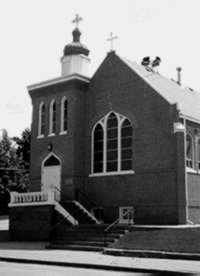The Greeks first arrived in South Omaha, Nebraska, in 1904, brought in as strikebreakers in the local meat-packing industry. That didn’t exactly endear them to the community, but they settled in, and by 1907, over 2,000 Greeks were reportedly living in the city. It wasn’t long before they built a church, dedicated to St. John the Baptist.
On February 19, 1909, a Greek worker named John Masourides shot and killed a respected police officer. For many residents of South Omaha, this was the last straw: the Greeks had to go.
Two days after the incident, a mass meeting was called to decide how to “rid the city of the undesirable Greeks.”At the close of the meeting, a mob descended on the Greek quarter. They attacked the Greeks, rioted, and destroyed property. The Greeks fled the city. The governor called in the National Guard. Order was restored, but the bigots of South Omaha had accomplished their goal: the Greeks were gone, and most of them would never return. The mass exodus almost wiped out the parish of St. John the Baptist.
As if all that wasn’t enough, a year later, a young Greek named Nicholas Jimikas was shot and killed by police. He is buried in an unmarked grave in Omaha’s Fort Lawn Cemetery.
Masourides, the Greek man whose shooting of a policeman sparked the riots, was initially convicted of first-degree murder, and sentenced to death. He appealed to the Nebraska Supreme Court, which reversed the decision. In the end, Masourides was convicted of second-degree murder and sentenced to fourteen years in prison, but less than halfway through that sentence, he was furloughed by the governor and then deported. (To read more about the Masourides case, see Masourides v. State in the Northwestern Reporter, volume 125. Also see this page, dedicated to Edward Lowry, the police officer killed by Masourides.)
For more on the Omaha riots, see this US Congressional report from 1916, which gives a lot of details. Also, see a profile of St. John the Baptist church, written by Jim Golding and published in the December 1999 issue of the Greek Archdiocese’s Orthodox Observer. Interestingly, the history on the Omaha parish website makes literally no mention of the 1909 riots and their effects on the parish.
[5/10/16 update: An earlier version of this article stated that Nicholas Jimikas was lynched, not just shot, by police. I believe I based this statement on Jim Golding’s 1999 article on the Omaha parish. Recently, Steve Frangos decided to investigate this claim, and he found no contemporary evidence that Jimikas was lynched. According to Frangos, “The Omaha Daily Bee reports that Jimikas died on June 14, 1910 of gun shot wounds; the Iowa State Bystander June 17, 1910 reports Jimikas was fatally shot and the Omaha World-Herald July 10, 1910 carries a story on how the Ottoman government wants to know the circumstances of Jimikas’ death—since that account reports Jimikas was shot by a policeman.” Without any better evidence that Jimikas was lynched, I’ve revised the article above to say that he was shot.]
